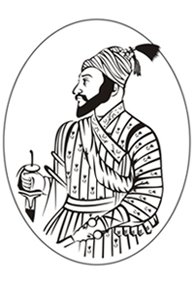Shivaji was returning after sacking Surat (3 October 1670) for the second time. His stern orders to the Mughal officers at Surat were to send every year Rupees12 lacs as annual payment or suffer the consequences. "War must pay for war. It is the Mughal Emperor who has brought war in Maharashtra. And therefore, he must bear the burden of war I have to wage against him", was his rationale for plundering the Mughal territories, including the towns and rich ports like Surat.
Arriving near Chandwad (Chandor) after crossing the Chandor range, he found that a large Mughal army under Daud Khan was barring his path. Daud Khan had correct information through his spies about Shivaji's movements and was ready to give battle. Shivaji's dilemma was how to send safely the vast treasure he was bringing from Surat and to minimize casualties.
Shivaji at once divided his army into four columns, each under a clever and resourceful commander and managed to send the treasure safely under a small escort by a secret route.
A fierce obstinate battle was fought for hours between the two sides between Vani and Dindori. Daud Khan, Ikhilas Khan, Sangram Khan and other important Mughal nobles fought with great courage using their artillery, though with limited advantage. On the Maratha side, Shivaji himself was conducting the operations in this one of the few open battles fought man to man,. The battle ended with about 3000 Mughal troops dead and a number of Mughal officers captured. The Marathas also captured about 4000 horses. The Mughal governor of Dindori, Siddi Hilal, was allowed to join Shivaji's service. In this way Shivaji won a great victory in this battle which neutralized Mughal power in this region for quite some time.
In this battle scene, Shivaji, mounted on a black horse, is directing the Maratha offensive against the Mughal troops of Daud Khan. The Maratha cavalry has managed to take the enemy in the rear while the famous Mavle infantry is engaging the enemy in a bitter hand to hand fight.
Arriving near Chandwad (Chandor) after crossing the Chandor range, he found that a large Mughal army under Daud Khan was barring his path. Daud Khan had correct information through his spies about Shivaji's movements and was ready to give battle. Shivaji's dilemma was how to send safely the vast treasure he was bringing from Surat and to minimize casualties.
Shivaji at once divided his army into four columns, each under a clever and resourceful commander and managed to send the treasure safely under a small escort by a secret route.
A fierce obstinate battle was fought for hours between the two sides between Vani and Dindori. Daud Khan, Ikhilas Khan, Sangram Khan and other important Mughal nobles fought with great courage using their artillery, though with limited advantage. On the Maratha side, Shivaji himself was conducting the operations in this one of the few open battles fought man to man,. The battle ended with about 3000 Mughal troops dead and a number of Mughal officers captured. The Marathas also captured about 4000 horses. The Mughal governor of Dindori, Siddi Hilal, was allowed to join Shivaji's service. In this way Shivaji won a great victory in this battle which neutralized Mughal power in this region for quite some time.
In this battle scene, Shivaji, mounted on a black horse, is directing the Maratha offensive against the Mughal troops of Daud Khan. The Maratha cavalry has managed to take the enemy in the rear while the famous Mavle infantry is engaging the enemy in a bitter hand to hand fight.

